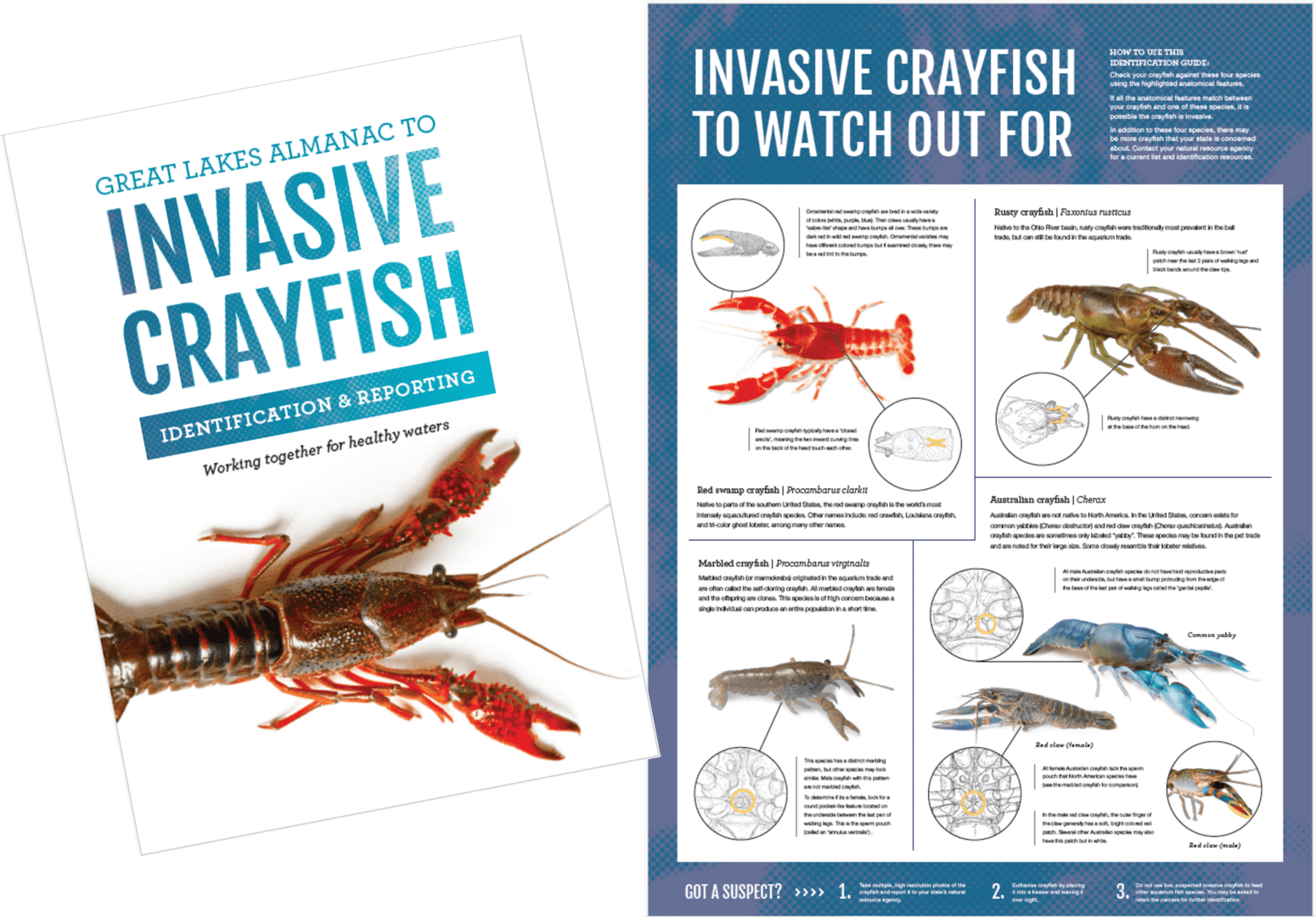Great Lakes Almanac to Invasive Crayfish
Download the Almanac (PDF)
Background
Crayfish are essential members of aquatic ecosystems, serving as a food source for many animals and contributing to ecosystem balance. They are also popular as aquarium pets. Unfortunately, well-meaning people who keep crayfish as pets sometimes release them into waterbodies, where they have the potential to become invasive and harmful to our environment.
Crayfish identification can be challenging. With over 600 crayfish species worldwide, it's difficult to figure out if a crayfish is a pesky invader. Retail crayfish are especially difficult to identify because they have been bred to have diverse colors, color patterns, and shapes. For this reason, physical features, not color alone, should be used to determine a species. Research has shown that crayfish are not always sold at the wholesale or retail level with accurate labels, adding another layer of complexity. When scientific names are provided on labels, they can also be inaccurate. Sometimes simple, common names such as "red crayfish", "white crayfish", or "striped crayfish" have been used to describe the same species. This confusion adds to the difficulty on distinguishing between native and potentially harmful non-native species.

Suggested Citation: Filice, P., W. Budnick, R. Feagley, B. Roth, and L. Nathan. 2024. Great Lakes Almanac to Invasive Crayfish: Identification and Reporting.
URL: invasivecrayfish.org/almanac
Description of Contents
The Great Lakes Almanac to Invasive Crayfish is an outreach product designed to be used for the identification and reporting of invasive crayfish in the pet industry. It highlights four invaders: Rusty Crayfish (Faxonius rusticus), Red Swamp Crayfish (Procambarus clarkii), Marbled Crayfish (Procambarus virginalis), and Australian crayfish (Cherax species). For each crayfish species, a detailed description and illustration is provided highlighting significant physical features that can be used to identify the species.
This product was translated into Hmong, simplified Chinese, and Spanish. Because of the number of folders and files, it is highly recommended that the Almanac and associated files be saved to a dedicated high-level directory (e.g., its own folder on the Desktop) to avoid path length errors during file extraction. The product is available for reprint and electronic use in the subdirectories described as follows (contents also generally described):
- A printing guidelines document created to ensure accurate folding of the final product (17.5” x 24” poster) and a README file describing the subdirectory
- Individual folders containing PDFs of the Almanac suitable for printing in multiple languages
- README file explaining folder contents
- Individual folders containing Electronic ADA accessible versions in multiple languages
All correspondences regarding this document and its contents should be addressed to either P. Filice or W. Budnick.
Paige Filice, Michigan State University Extension, filicepa@msu.edu
William R. Budnick, Department of Fisheries and Wildlife, wbudnick@usgs.gov
Acknowledgements
The authors of this document wish to thank many authors for their insight and contributions to the development of this product. Funding for this product was provided by the Great Lakes Restoration Initiative. The authors thank partners from Minnesota Department of Natural Resources (Tina Fitzgerald, Doug Jensen, Rafael Contreras-Rangel), Wisconsin Department of Natural Resources (Patrick Siwula, Liz Tanner, Maureen Kalscheur, Amy Kretlow, Bob Stroess), Michigan Department of Natural Resources (Kathleen Quebedeaux), Illinois Department of Natural Resources (Brian Schoenung), Indiana Department of Natural Resources (Eric Fischer), Illinois/Indiana Sea Grant (Greg Hitzroth, Katie O’Reilly, Natalia Szklaruk), Ohio Department of Natural Resources (John Navarro), Buffalo State University (Christopher Pennuto, Theo Berenson), Eric Larson (University of Illinois – Champaign-Urbana), Lindsey Chadderton (The Nature Conservancy), Reuben Keller (Loyola University – Chicago), and Tom Hrbaik (University of Minnesota-Duluth). The authors wish to also thank Dr. Premek Hamr for the illustrations provided for this document and additional crayfish expertise.
